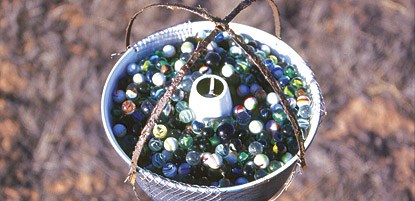
NPS Photo by Neal Herbert Dust storms have long been associated with erosion of topsoil, poor air quality and other harmful effects. In March of this year, a dust storm from the Gobi Desert in northwest China cast much of southeast Asia in a pallid gloom as airports canceled flights and health officials warned people to carry umbrellas and wash when they returned home. Residents of Utah faced similar storms in April. But dust isn’t all bad: scientists working in Canyonlands have discovered that airborne dust can be extremely beneficial to the area in which it falls. Any local gardener will agree that it’s a miracle anything grows in Canyonlands without the advantage of compost, manure and daily irrigation. Despite natural obstacles like extreme temperatures and lack of water, native plants endure, even surprising visitors with their abundance. Airborne dust may be one reason for this success. As much as 30% of the soil in Canyonlands may have arrived as airborne dust. Dust can be distinguished from other sediments because it differs in mineral and chemical composition from nearby bedrock, the only other source of soil-building material in many areas. According to lab results, dust both introduces new elements and enriches many others consumed by plants. For example, dust doubles the amount of phosphorous and manganese, triples the amount of sodium, and more than quadruples the amount of magnesium in the soil. Imagine food falling from the sky, filling your fridge and three others just like it. It’s a virtual feast for the plant community. Examining new elements helps identify potential dust sources, though naming exact origins remains impossible. Given the right conditions, dust can travel halfway around the world, and frequently does. A Gobi Desert storm last year crossed the Pacific and sprinkled tons of Asian dust from California to Florida. It was the largest storm ever recorded, and noticeably affected visibility in Canyonlands as it passed. Most dust destined for Canyonlands probably originates in the American Southwest. The Mojave, Great Basin and Sonoran deserts are all upwind of the park, and recent satellite images have recorded dust plumes traveling from the Mojave to the Canyonlands area. Soil profiles in Canyonlands indicate a change in sources during the past several decades, so it’s possible that human modifications like farming, grazing, military testing, urban development and water diversions have made the Mojave more prone to erosion. Not surprisingly, the Gobi has witnessed many of the same activities. Soil loss can be devastating to the ecosystem in which it occurs, and the newly airborne nutrients only benefit soils that can retain them. In Canyonlands, this job falls to biological soil crust, a living groundcover and efficient dust trap found throughout the park. The lumpy, irregular surface of healthy crusts combs dust particles from the air and shelters them. When it rains, bacteria living in the crust actually bind the dust particles to existing soils in a sticky, fibrous web. While it can withstand wind, the flattening impact of feet or wheels crushes crust back into dust, which may float away on the next breeze. More importantly, the formation of healthy soil crust requires up to half a century. Protecting park soils is a small but significant step every visitor can take. Stay on roads and trails, and hike on rock or in sandy washes during any off-trail explorations. And don’t forget, the soil under your shoes may have traveled all the way from China. |
Last updated: February 24, 2015
